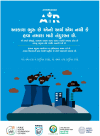Development of Ahmedabad's Air Information and Response (AIR) Plan to Protect Public Health
- PMID: 29996566
- PMCID: PMC6068810
- DOI: 10.3390/ijerph15071460
Development of Ahmedabad's Air Information and Response (AIR) Plan to Protect Public Health
Abstract
Indian cities struggle with some of the highest ambient air pollution levels in the world. While national efforts are building momentum towards concerted action to reduce air pollution, individual cities are taking action on this challenge to protect communities from the many health problems caused by this harmful environmental exposure. In 2017, the city of Ahmedabad launched a regional air pollution monitoring and risk communication project, the Air Information and Response (AIR) Plan. The centerpiece of the plan is an air quality index developed by the Indian Institute of Tropical Meteorology’s System for Air Quality and Weather Forecasting and Research program that summarizes information from 10 new continuous air pollution monitoring stations in the region, each reporting data that can help people avoid harmful exposures and inform policy strategies to achieve cleaner air. This paper focuses on the motivation, development, and implementation of Ahmedabad’s AIR Plan. The project is discussed in terms of its collaborative roots, public health purpose in addressing the grave threat of air pollution (particularly to vulnerable groups), technical aspects in deploying air monitoring technology, and broader goals for the dissemination of an air quality index linked to specific health messages and suggested actions to reduce harmful exposures. The city of Ahmedabad is among the first cities in India where city leaders, state government, and civil society are proactively working together to address the country’s air pollution challenge with a focus on public health. The lessons learned from the development of the AIR Plan serve as a template for other cities aiming to address the heavy burden of air pollution on public health. Effective working relationships are vital since they form the foundation for long-term success and useful knowledge sharing beyond a single city.
Keywords: India; air pollution; climate change; community engagement; environmental education; environmental forecasting; exposure mitigation; risk communication; urban public health; vulnerability.
Conflict of interest statement
The authors declare no conflict of interest.
Figures




References
-
- Health Effects Institute State of Global Air. [(accessed on 25 April 2018)];2018 Available online: https://www.stateofglobalair.org/sites/default/files/soga-2018-report.pdf.
-
- Lim S.S., Vos T., Flaxman A.D., Danaei G., Shibuya K., Adair-Rohani H., AlMazroa M.A., Amann M., Anderson H.R., Andrews K.G., et al. A comparative risk assessment of burden of disease and injury attributable to 67 risk factors and risk factor clusters in 21 regions, 1990–2010: A systematic analysis for the Global Burden of Disease Study 2010. Lancet. 2012;380:2224–2260. doi: 10.1016/S0140-6736(12)61766-8. - DOI - PMC - PubMed
-
- Lvovsky K. Economic costs of air pollution with special reference to India; Proceedings of the National Conference on Health and Environment; Delhi, India. 7–9 July 1998.
-
- Cohen A., Anderson H.R., Ostro B., Pandey K., Krzyanowski M., Kunzli N., Gutschmidt K., Pope C.A., Romieu I., Samet J.M., et al. Urban Air Pollution. WHO; Geneva, Switzerland: 2004.
Publication types
MeSH terms
LinkOut - more resources
Full Text Sources
Other Literature Sources
Medical

